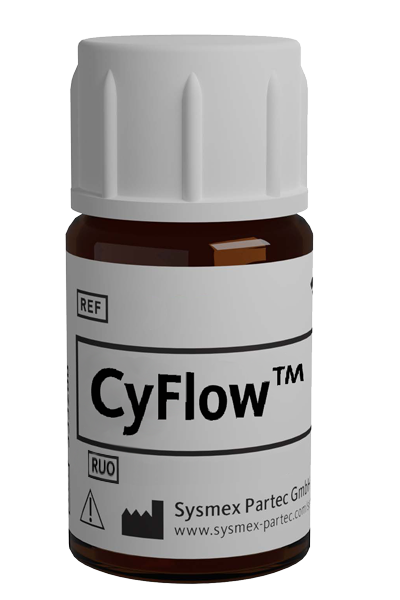CyFlow™ IgG1 Alexa Fluor™ 647

| Antibody: | Yes |
| Antigen: | IgG1 Isotype Control |
| Application: | Flow cytometry (Isotype control) |
| Clonality: | monoclonal |
| Clone: | MOPC-21 |
| Emission Maximum: | 665 nm |
| Excitation Maximum: | 650 nm |
| Field of Interest: | Isotype controls |
| Format/Fluorochrome: | Alexa Fluor™ 647 |
| Isotype: | IgG1 |
| Laser: | Red |
| Regulatory Status: | RUO |
| Source Species: | Mouse |
| Product number: | AP602054 |
For Research Use Only
| Concentration Unit | mg/mL |
| Concentration | 1 |
| Quantity | 0.1 mg |
| Volume | 0.1 mL |
| Immunogen | Not available |
| Background Information | The specificity of staining by monoclonal antibodies to target antigens should be verified by establishing the amount of non-specific antibody binding. Especially at higher concentration (more than 15 μg/ml) the antibody staining usually has consignable background. To this end a non-reactive immunoglobulin of the same isotype is included as a negative control for each specific monoclonal antibody used in a particular immunoassay. The monoclonal antibody MOPC-21, generated against an undefined antigen, does not react specifically with rat and human samples, and hence all the background that could be observed when working with this antibody would be a result of general nonspecific interactions between an mouse IgG1 molecule and the respective sample under the particular conditions. This shall help the customer to set up the experimental conditions so that the nonspecific binding of any antibody is abolished. |
| Usage | The reagent is designed as an isotype control for Flow Cytometry analysis. To establish the amount of non-specific antibody binding, match the concentration of the correct isotype to the recommended working concentration of the antigen-specific antibody. If the background signal of the isotype control is too high (usually when working antibody concentrations are above 10·µg/ml of incubation mixture), change the experimental conditions to reduce the background. |
| Storage Buffer | The reagent is provided in phosphate buffered saline (PBS) solution, pH ≈7.4, containing 0.09% (w/v) sodium azide. |
| Storage | Avoid prolonged exposure to light. Store in the dark at 2-8°C. Do not freeze. |
| Stability | Do not use after expiration date stamped on vial label. |
| Wiendl H, Mitsdoerffer M, Schneider D, Melms A, Lochmuller H, Hohlfeld R, Weller M: Muscle fibres and cultured muscle cells express the B7.1/2‑related inducible co‑stimulatory molecule, ICOSL: implications for the pathogenesis of inflammatory myopathies. Brain. 2003 May; 126(5):1026‑35. < PMID: 12690043 > | Bryceson YT, March ME, Barber DF, Ljunggren HG, Long EO: Cytolytic granule polarization and degranulation controlled by different receptors in resting NK cells. J Exp Med. 2005 Oct 3; 202(7):1001‑12. < PMID: 16203869 > | Carlsten M, Björkström NK, Norell H, Bryceson Y, van Hall T, Baumann BC, Hanson M, Schedvins K, Kiessling R, Ljunggren HG, Malmberg KJ: DNAX accessory molecule‑1 mediated recognition of freshly isolated ovarian carcinoma by resting natural killer cells. Cancer Res. 2007 Feb 1; 67(3):1317‑25. < PMID: 17283169 > | Yates J, Rovis F, Mitchell P, Afzali B, Tsang JY, Garin M, Lechler RI, Lombardi G, Garden OA: The maintenance of human CD4+ CD25+ regulatory T cell function: IL‑2, IL‑4, IL‑7 and IL‑15 preserve optimal suppressive potency in vitro. Int Immunol. 2007 Jun; 19(6):785‑99. < PMID: 17545278 > | Rebetz J, Tian D, Persson A, Widegren B, Salford LG, Englund E, Gisselsson D, Fan X: Glial progenitor‑like phenotype in low‑grade glioma and enhanced CD133‑expression and neuronal lineage differentiation potential in high‑grade glioma. PLoS One. 2008 Apr 9; 3(4):e1936. < PMID: 18398462 > | Smed-Sörensen A, Moll M, Cheng TY, Loré K, Norlin AC, Perbeck L, Moody DB, Spetz AL, Sandberg JK: IgG regulates the CD1 expression profile and lipid antigen‑presenting function in human dendritic cells via FcgammaRIIa. Blood. 2008 May 15; 111(10):5037‑46. < PMID: 18337560 >
